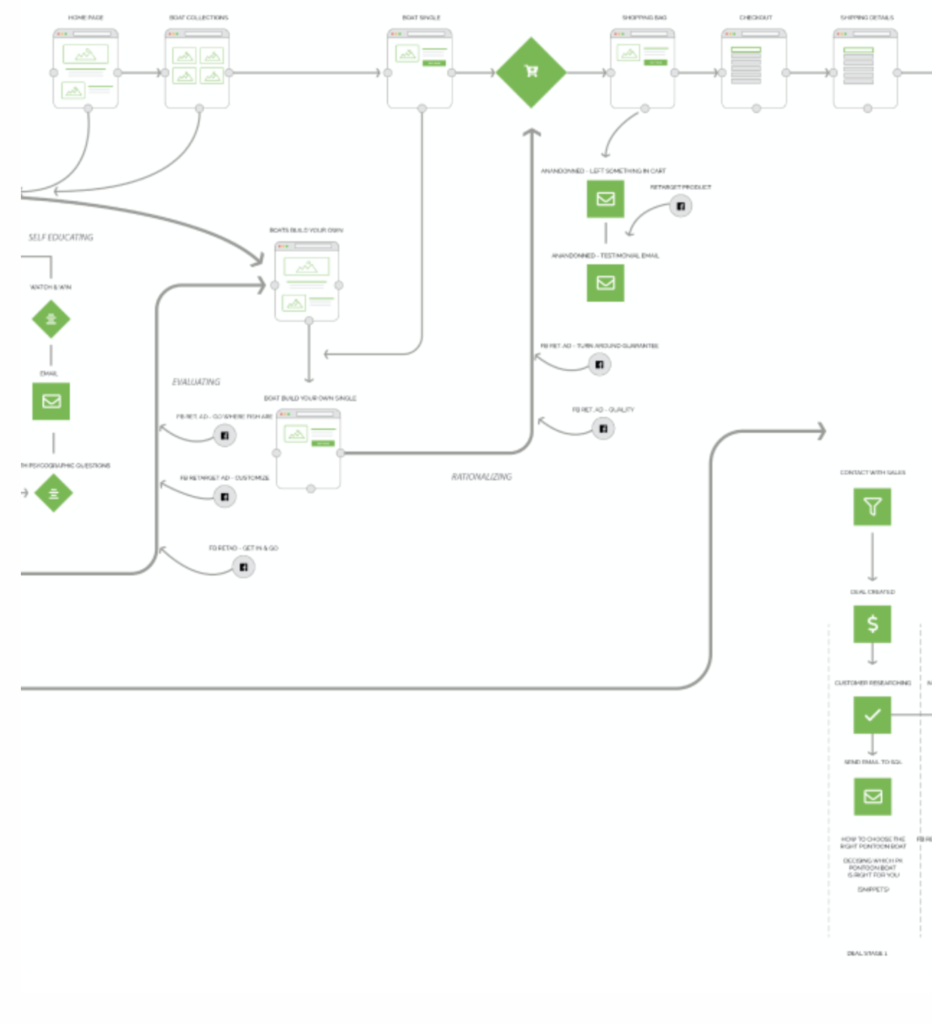8 Must-Have Content Marketing Skills!
Content marketing skills are powerful, but only if done right.
It’s researching what your specific audience wants to know. It’s talking to them as a friend, in your own unique way and voice. It’s keeping up with current trends, so you can create valuable content that resonates with your audience.
Follow along this blog and learn 8 skills to master and lift you to success in no time.
1. Research Your Audience
No matter how compelling your content is, you won’t convert anyone if you don’t know exactly who you’re speaking to.
For instance, look at this content from Pond King’s email campaign.

The email holds enticing promise to readers who want to purchase in the near future. But what makes it compelling isn’t fancy wording or clever phrases. It’s simply that we knew his audience’s pain and need before writing it.
When we are identifying our target customer’s pain we use these five powerful methods to dig up clues about our audience so we can find them a solution. Here are a 5 powerful ways to put on your detective’s cap and dig up clues about your audience:
- Use Google Analytics to find out who’s visiting your website. Analytics gives you information like the names, ages, and genders of your site visitors.
- Go on Answer The Public and research topics around your niche. What are people saying? What are their fears/desires/dreams? Reading what they talk about will help you understand them on a deeper level.
- Take note of how users respond to your content. With a tool like Moz , you can learn how people are reacting to what you write. Analyze your top engaged posts and discover what made them appealing to your audience.
- Ask your users through surveys (with incentives like free downloads – an e-book).
- Engage with people in the comment section of your blog and social media. Listen to what they’re saying and respond personally and directly.
Remember, speaking to your audience should be like conversing with a friend. The better you know this friend, the more personal and appealing your message will be.
2. Become an Expert Interviewer
To write amazing content, you need to be an expert on your topic. When you master the art of conducting subject matter interviews, you can produce authority content even if you are not an expert in the niche you write in.
But you can’t just jump into an interview with an expert and ask any question that comes to your mind. Remember, the value of the information you get depends on the quality of your questions.
Here are 5 tips to make your interviews seamless.
- Be prepared. You don’t want to come to an interview with absolutely no idea on the topic. Rather, you want the interview to be a deep dive into the topic. So, before you start the interview, do as much research as you can. From your research, make a list of questions you can’t find the answers for online.
- Skip open-ended questions. You want your interviewee to gush over the topic. You want them to feel excited. To do that, intrigue them with unusual questions. For instance, instead of asking, “Is your product great?” you can ask, “Can you give me some facts most people don’t know about your product?”
- Bring your content outline with you when you interview. Asking a bunch of random, unrelated questions wastes time. To avoid this, base your questions on the outline you prepare for your content. This will help you ask specific, driven questions you can use in your writing.
- Record your conversation. Later on, you’ll want to go back over the exact words your interviewee said during the interview. Then you can write notes later without disrupting the interview process. If your interview is through zoom we love using Otter. It takes notes for you so you can save them for later and spend more time focusing on your content outlines.
- Don’t be afraid to ask for clarification. If there’s something you don’t understand during the interview, ask! This can open doors for an even deeper dive into the topic.
When you approach interviews with a genuine passion for your topic, there’s nothing you can’t dig up from the experts’ knowledge banks.
3. Fine Tune Your Keywords
So, how do you choose keywords to use in your content? Keywords don’t only help you rank higher on Google, they act as the spine of your content. Keywords direct what you say and allow you to stay relevant with what people want to read.
- Go for long-tail keywords. For example, instead of choosing “dress,” go for “Walt Disney princess dresses for kids.” Keywords like this help direct quality traffic to your site.
- Choose low competition keywords. If you go for a keyword like “shoes,” you’ll find yourself up against content from huge brands like Adidas and Nike. As a rule of thumb, go for keywords with a score below 50.
- It’s OK to select a keyword with low search volume. As long as there are people searching for this keyword, creating content around it will get you results.
To help you find the best keywords for your content, you can use tools like Ahrefs and SEMrush.
Did you know?
76% of marketers use organic traffic as a measure of content success
4. Planning and Time Management
So, how do you choose keywords to use in your content? Keywords don’t only help you rank higher on Google, they act as the spine of your content. Keywords direct what you say and allow you to stay relevant with what people want to read.
You don’t want to wake up one morning panicking because you have to produce content but have no idea what to write. To avoid this, create a content calendar.
With a content calendar, you’ll avoid problems like repetitive content and stay up-to-date with events like holidays and special occasions.
Always remember, to leave room for spontaneity. For example, if a relevant question from one of your followers suddenly pops up on your social feed, why not address it at length in a blog?
After you’ve solidified your idea and did your research next comes your outline.
5. Creating Strategic Outlines
An outline is your roadmap to the content you create. It not only helps you with your work but also shows the client what to expect. Put as much detail into your outline as possible. Take a look at our example outline below.

6.Writing Value-rich Content
When you write, put yourself in your customers’ shoes. Ask yourself, would I read this? Did I learn from what I just read? Was it a user friendly experience? The content you write is the solution to your audience’s pain point.
74.2% of companies saying that content marketing is increasing their marketing teams’ lead quality and quantity.
If you want to improve your content here are 4 simple steps to follow:
Step 1: Understand what data-rich content entails.
When writing a data-rich blog post, every key point that you make should be backed by a credible data source. The more legitimate your source is, the more authoritative your content will be.
Step 2: Firm up your content marketing strategy.
Firming up your content marketing strategy and what you want to accomplish with your content, most specifically, will allow you to cut out the guesswork and get consistent results.
Each content you write needs to have a clear purpose. Understand who your audience is and the information that they want to gain from reading your blog post.
Step 3: Come up with engaging headlines.
While most people will read your headlines, few will commit to actually reading the blog post. You have less than 3 seconds to grab your reader’s attention, and a data-driven headline will leave your audience wanting more.
Step 4: Develop data-driven outlines.
Do you create outlines for your blog posts? Whether you’re writing a data-driven post or sharing your unique perspective about a relevant topic, developing an outline will speed up the blog writing process and keep you organized and on track.
7. Editing
Engaging content can be powerful enough to persuade hesitant prospects to buy. And, on the flip side, messy, error-prone writing could cause the end-user to abandon your site entirely.
In short, the ability to edit is the difference between mediocre writing and compelling, engaging, high-converting content.
We love using grammarly.com, it helps whip your content in shape and checks for things like:
- Proofreading
- Revising
- Drafting
- Spelling
- Structure
- Style
- Punctuation
- Strong Vocabulary
- Using the Rhetorical Triangle
- Devise Structure
- Establish Tone
- Forming a Thesis
8. Measuring Your Content’s Success

Analyzing data is the key to knowing if your content performed well and if you need to make changes. Attaching metrics to your content will help you determine whether the content is successful or needs improvement. Here are three great ways to measure content success:
- Email click-through rate. If people are clicking the links in your email campaigns, take note of what makes this email different from others.
- Bounce rate. Do people leave your site without clicking through to other pages? The rate at which they do so is your bounce rate. If people click away more than 70% of the time, you need to improve your content.
- Scroll depth. Do people read your intro and then leave the page? Or do they scroll all the way to the bottom? At what point do they stop reading? When you analyze what’s working and what’s not, you’ll be able to improve your content.
Marketers need to constantly learn new skills and adapt to online changes. As online behavior and algorithms shift, so do marketing tactics – and therefore marketing best practices. Marketers that thrive on this change and are eager to learn new techniques will succeed.
Once you hone in on these skills it’s only up from here. Your content will improve and so will you as a professional.


















